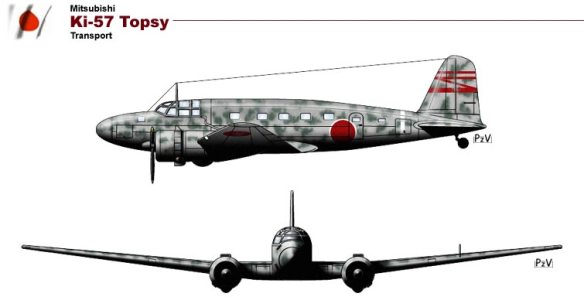
1) Celebes Island [NEI] Menado-Kema area [target Langoan Airfield]; IJN 1 Yokosuka SNLF (Air) [CO Cdr Toyoaki Horiuchi]; 334 men were dropped from G3M1-L transport aircraft on 11 Jan 1942 and 185 more paratroops on 12 Jan 1942.
2) Sumatra Island [NEI] Palembang area [target Palembang 1 Airfield]; IJA 2 Parachute Regiment of 1 Parachute Brigade [CO Col Seiichi Kume]; 360 paratroops were dropped from Ki-56 and Ki-57 transport aircraft on 14 Jan 1942 and 100 more men on the next day.
3) Timor Island [NEI] Dili-Koepang area [target Penfoei Airfield]; IJN 3 Yokosuka SNLF (Air) [CO Lt Cdr Koichi Fukumi]; 308 paratroops were dropped from G3M1-L planes on 20 Feb 1942 and 323 more on the next day. Seizing of Timor was the first combined paratroop and amphibious operation in the history of warfare. IJN marines and IJA amphibious units also took part in this operation. Additionally participating forces were covered by F1M2 floatplanes from the seaplane carrier MIZUHO.
All three paratroop operations carried out in the beginning of the war were successful.
4) Leyte Island [the Philippine Islands] [target network of airfields seized by US forces]; IJA 3 Parachute Regiment – Katori Shimpei Force [CO Lt Col Tsunehiro Shirai]; 409 paratroops were dropped on 6 Dec 1944 from Ki-57 planes. Operation WA ended in disaster as IJA paratroops were not able to hold their initial gains and were wiped out by overwhelming US forces.
As an appendix we could add commando [teishin I suppose] operations.
On the night of 24/25 May 1945 9 Ki-II-b of IJAAF 3 Dokuritsu Hikotai [stripped of all armament] with commandos aboard from Giretsu-tai were sent against US-held Yontan Airfield [Okinawa Island]; only one had plane reached the target and 12 commandos it was carrying were able to destroy 7 US planes and damage 26 more. Large supplies of fuel and ammo were also destroyed. All Japanese were killed. What a contrast to the operation of Navy PO Satoru Ono of 15 Kokutai from 18 Jul 1938 in Nanchang. He was able to land on the airfield, set Chinese planes on fire and return safely to base. But we can not compare formidable American units with poorly led and equipped Chinese.
The last operation was mentioned by Katsuhiro Uchida – Tsurugi in his excellent posting. On 9 and 10 Aug 1945 US carrier planes had destroyed almost 200 planes and thus prevented the Japanese from carrying out of Operation Tsurugi – commando raid on Marianas.
Sasebo 101th SNLF was isolated in Truk and Rabaul and was disbanded in June, 1944.
This “Submarine SNLF” was merged to Kure 101st SNLF led by Lt. Cdr. YAMAOKA, Daiji (Etajima 63rd graduation class). Kure 101st was basically a “Submarine SNLF” and would attack Mainland America, but their duty was changed into “landing on Marianas from G4Ms on the ground”.
Thirty G4Ms were prepared for this “Tsurugi Sakusen”, but these thirty planes were attacked on Misawa Naval Air Base on July 14, 1945 by US carrier planes.
Some of the planes were repaired and new G4Ms were prepared again. Totally sixty G4Ms were prepared for the second chance which would be going on Aug. 19, 1945.
There was one more “Submarine SNLF” called Yokosuka 105th SNLF led by Lt. Cdr. KAGA, Makoto (Etajima 65th graduation class).
According to Lt. Cdr. YAMABE, Masao (Etajima 66th graduation class), the documents about these “Submarine/Air SNLFs” were not left because the plans for these units were NOT written on paper in those days. These operations were the top secrets of IJN.
Japanese small arms
Like many nations, Japanese small arms designers modified existing weapons to create the TERA series. TERA weapons were a class of Japanese rifle and submachine gun that could be broken down or collapsed to enhance portability.
The two best examples of TERA weapons with the Type 2 bolt action break-down rifle and the Type 100 submachine gun. It’s believed by some the Japanese began a real push into airborne specialized weapons after their first combat drop on the Dutch East Indies in 1942.
During that operation Japanese paratroopers arrived at the drop zone separately from their canistered weapons and that separation, including canisters lost to swamps, realigned Imperial Japanese thinking on jumpable small arms.
The Type 2 was a derivative of the full-sized Type 99 Arisaka rifle. Chambered in 7.7mm the Arisaka was the starting point for the Type 2 rifle that would be deployed by the Teishin (Army special forces) and Rikusentai (marine paratroopers.)
The first version of the bolt action Japanese paratrooper rifle was built on a threaded barrel extension that would screw into the receiver assembly. However, the Japanese went in a different direction with a notch and wedge to join the forearm assembly and the receiver.
By joining the forearm/barrel assembly into the receiver a paratrooper could quickly twist into place the wedge located on the rifle’s right side.
While a full-power rifle was standard for Imperial paratroopers, submachine gun technology lagged behind (an interesting comparison to Allied strategists to whom submachine guns seemed natural armaments of the airborne infantry.)
Where the Type 2 was a two piece break-down rifle, the Type 100 was a wood stocked SMG that was cut and hinged at the back of the receiver. This simple move allowed the creation of a folding stock version of a standard rigid stock 8mm weapon.
Touches unusual to the Japanese SMG, compared to their enemy’s small-arms designs, was the addition of a bayonet and bipod. A smart and important internal modification was a chromed bore.
Knowing the tropical battlefields of the Pacific are the rust inducing enemies of small-arms, the chrome bore helped prevent this weapon jamming syndrome (a lesson the U.S. neglected to remember when issuing the first generation of un-chromed M-16s.)